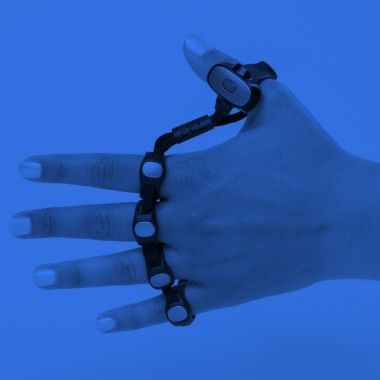From MIT's Technology Review, Oct. 13:
We’ve been using it to type for 144 years. Here’s why it works, and what it would take for us to give it up.
Tap is a one-handed gadget that fits over your fingers like rubbery brass knuckles and connects wirelessly to your smartphone. It’s supposed to free you from clunky physical keyboards and act as a go-anywhere typing interface. A promotional video shows smiling people wearing Tap and typing with one hand on a leg, on an arm, and even (perhaps jokingly) on some guy’s forehead.
Seems like a great idea, right? But when I tried it, the reality of using Tap was neither fun nor funny. Unlike a conventional QWERTY keyboard, Tap required me to think a lot, because I had to tap my fingers in not-very-intuitive combinations to create letters: an A is your thumb, a B is your index finger and pinky, a C is all your fingers except the index.

I memorized these combinations by playing simple letter-choosing games in an app, but it was quickly exhausting. It was almost impossible to type on my thigh, or on any surface that wasn’t flat and solid. My most verbose tweets were a handful of words long and took several minutes to compose. Even typing out “Duh!” was cumbersome and uncomfortable. After less than a week, I conceded defeat and retreated to my big, old-fashioned QWERTY and its soothing tactile feedback.
But while Tap didn’t work well for me, it brings up an important question about the evolution of technology. We have so many ways to input data—by voice, touch screen, stylus, you name it—and yet we still rely heavily on something that looks a heck of a lot like the first commercially successful typewriters, released nearly 150 years ago. We can make powerful computers that fit in our pockets. So why haven’t we quit the keyboard?
QWERTY’s quirky history
Part of the answer is inertia. The large, clunky keyboard is what you learned to type with, as did your parents and your grandparents (and maybe even your great-grandparents). It’s comfortable; Kevin Weaver, an assistant clinical professor of physical therapy at New York University, says that at this point most of the potentially bothersome ergonomic issues have been designed out of it.
“We’re stuck in a cycle,” says Frank Jones, an assistant professor of computer science at Brigham Young University and a creator of a finger-tracking touch-screen keyboard called DotKey. “We teach kids how to use QWERTY because it’s everywhere. Why is QWERTY everywhere? Because we teach kids to use it.”
This wasn’t always the case. Early typewriters included all kinds of creative key layouts and arrangements. But the one that stuck was the Sholes & Glidden Type-Writer, developed largely by Wisconsin journalist and inventor Christopher Latham Sholes, and sold by firearms maker E. Remington & Sons starting in 1874.
The Sholes & Glidden became the first popular typewriter, and it had a key format nearly identical to the QWERTY one we use today. It typed only in capitals, though, so reading Sholes’s early letters gives the impression that he’s shouting at the recipient.
It’s not clear how Sholes came up with the key arrangement, featured in an 1878 patent, though theories abound. But he was trained in the printing industry and was a newspaper publisher, so he would have been familiar with how typesetters organized their trays of letters by frequency of use.
In 2011, Kyoto University researchers proposed that QWERTY stemmed from key rearrangements made to satisfy the habits of the typewriter’s earliest customers: telegraph operators, who used it to transcribe Morse code messages. (For instance, some letters that are often confused for one another in Morse are close together on the keyboard.) Those researchers were challenging the oft-invoked bit of folklore that QWERTY was chosen to prevent typewriters from jamming when people hit commonly used letters in quick succession. Either way, in 1893, several of the largest typewriter makers combined to form the Union Typewriter Company. By the turn of the century, QWERTY was the typing standard.
After that, it wasn’t long before children started learning QWERTY. These days, US kids are required to be able to type with a keyboard by third grade, and some schools are teaching kids as young as kindergarten basic keyboard skills.
QWERTY dominates not just in countries that use alphabets (with some regional variations), but in countries like China that developed their own systems, such as Pinyin, to type a vast array of characters with the same simple keyboard.
But the QWERTY keyboard’s success has not been due to lack of competition.
The contenders
Way before Tap, there were numerous efforts to change the arrangement and form of the keyboard—such as the Dvorak Simplified Keyboard layout, patented in 1936 by University of Washington professor August Dvorak. More recently, there was the one-handed Twiddler keyboard. Neither managed to dent QWERTY’s dominance....MUCH MORE